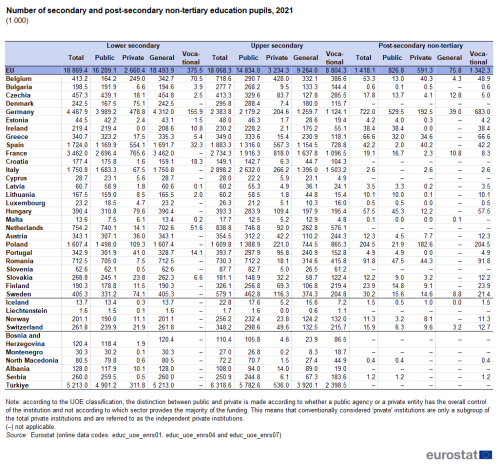
Participation by level
In the EU, there were 18.9 million pupils in lower secondary education in 2021 – see Table 1. The number of pupils in upper secondary education was slightly lower, at 18.1 million across the EU.
In 2021, contrary to the situation in the EU as a whole, upper secondary pupils outnumbered lower secondary pupils in most of the EU Member States; Germany and France were among the exceptions. In all of the EFTA countries, there were more upper secondary than lower secondary school pupils. By contrast, in most of the enlargement countries for which data are available there were more pupils in lower than upper secondary education; Türkiye was the exception.
Post-secondary non-tertiary education was by far the smallest of the three education levels covered by this article, with 1.4 million pupils in the EU in 2021. It should be noted that post-secondary non-tertiary education does not exist in some of the EU Member States (Denmark, Croatia, Cyprus, the Netherlands and Slovenia) and is relatively uncommon in several others; it also does not exist in Liechtenstein, Bosnia and Herzegovina, Montenegro, Albania or Türkiye.
For EU Member States, the number of post-secondary non-tertiary pupils in 2021 compared with the number of upper-secondary pupils ranged from 30.3 % in Germany to less than 2.0 % in Portugal, France, Malta, Bulgaria and Italy. As noted above, this education level does not exist in five Member States.
Public and private secondary education
In the EU, the vast majority (85.9 %) of lower secondary education pupils in 2021 were taught in public institutions, as defined in the UOE methodology – see notes [1]. At least two thirds of lower secondary school pupils were educated in public institutions across the vast majority of EU Member States. The only exceptions were Malta (54.9 %) and Belgium (39.7 %) – see Table 1.
A large majority (82.1 %) of pupils in upper secondary education in the EU were taught in public institutions in 2021. At least two thirds of pupils in upper secondary education were educated in public institutions in nearly all of the EU Member States; the only exception was Belgium where the share was 40.4 %.
Among the EU Member States which have post-secondary non-tertiary education, the situation in 2021 was somewhat different.
- Ireland, Luxembourg, Portugal and Lithuania each reported that more than 99.0 % of all post-secondary non-tertiary students were educated in public institutions; this pattern was repeated in North Macedonia and Serbia.
- All post-secondary non-tertiary students were educated in the private sector in Italy, with particularly high shares also observed in Spain (95.3 %) and Poland (89.3 %). Around three quarters of post-secondary non-tertiary students were educated in the private sector in Bulgaria and Belgium.
Participation by type of programme
In the EU, the vast majority (98.0 %) of lower secondary school pupils in 202
SDGs, Targets, and Indicators in the Article
SDGs, Targets, and Indicators
- SDG 4: Quality Education
- Target 4.1: By 2030, ensure that all girls and boys complete free, equitable and quality primary and secondary education leading to relevant and effective learning outcomes.
- Indicator 4.1.1: Proportion of children and young people (a) in grades 2/3; (b) at the end of primary; and (c) at the end of lower secondary achieving at least a minimum proficiency level in (i) reading and (ii) mathematics, by sex.
- Indicator 4.1.2: Participation rate of youth and adults in formal and non-formal education and training in the previous 12 months, by sex.
- SDG 5: Gender Equality
- Target 5.5: Ensure women’s full and effective participation and equal opportunities for leadership at all levels of decision-making in political, economic, and public life.
- Indicator 5.5.1: Proportion of seats held by women in (a) national parliaments and (b) local governments.
Analysis
1. Which SDGs are addressed or connected to the issues highlighted in the article?
The SDGs addressed or connected to the issues highlighted in the article are SDG 4: Quality Education and SDG 5: Gender Equality.
2. What specific targets under those SDGs can be identified based on the article’s content?
The specific targets under SDG 4 that can be identified based on the article’s content are:
– Target 4.1: By 2030, ensure that all girls and boys complete free, equitable and quality primary and secondary education leading to relevant and effective learning outcomes.
The specific target under SDG 5 that can be identified based on the article’s content is:
– Target 5.5: Ensure women’s full and effective participation and equal opportunities for leadership at all levels of decision-making in political, economic, and public life.
3. Are there any indicators mentioned or implied in the article that can be used to measure progress towards the identified targets?
The indicators mentioned or implied in the article that can be used to measure progress towards the identified targets are:
– Indicator 4.1.1: Proportion of children and young people (a) in grades 2/3; (b) at the end of primary; and (c) at the end of lower secondary achieving at least a minimum proficiency level in (i) reading and (ii) mathematics, by sex.
– Indicator 4.1.2: Participation rate of youth and adults in formal and non-formal education and training in the previous 12 months, by sex.
– Indicator 5.5.1: Proportion of seats held by women in (a) national parliaments and (b) local governments.
Table: SDGs, Targets, and Indicators
| SDGs | Targets | Indicators |
|---|---|---|
| SDG 4: Quality Education | Target 4.1: By 2030, ensure that all girls and boys complete free, equitable and quality primary and secondary education leading to relevant and effective learning outcomes. | Indicator 4.1.1: Proportion of children and young people (a) in grades 2/3; (b) at the end of primary; and (c) at the end of lower secondary achieving at least a minimum proficiency level in (i) reading and (ii) mathematics, by sex. Indicator 4.1.2: Participation rate of youth and adults in formal and non-formal education and training in the previous 12 months, by sex. |
| SDG 5: Gender Equality | Target 5.5: Ensure women’s full and effective participation and equal opportunities for leadership at all levels of decision-making in political, economic, and public life. | Indicator 5.5.1: Proportion of seats held by women in (a) national parliaments and (b) local governments. |
Behold! This splendid article springs forth from the wellspring of knowledge, shaped by a wondrous proprietary AI technology that delved into a vast ocean of data, illuminating the path towards the Sustainable Development Goals. Remember that all rights are reserved by SDG Investors LLC, empowering us to champion progress together.
Source: ec.europa.eu

Join us, as fellow seekers of change, on a transformative journey at https://sdgtalks.ai/welcome, where you can become a member and actively contribute to shaping a brighter future.







